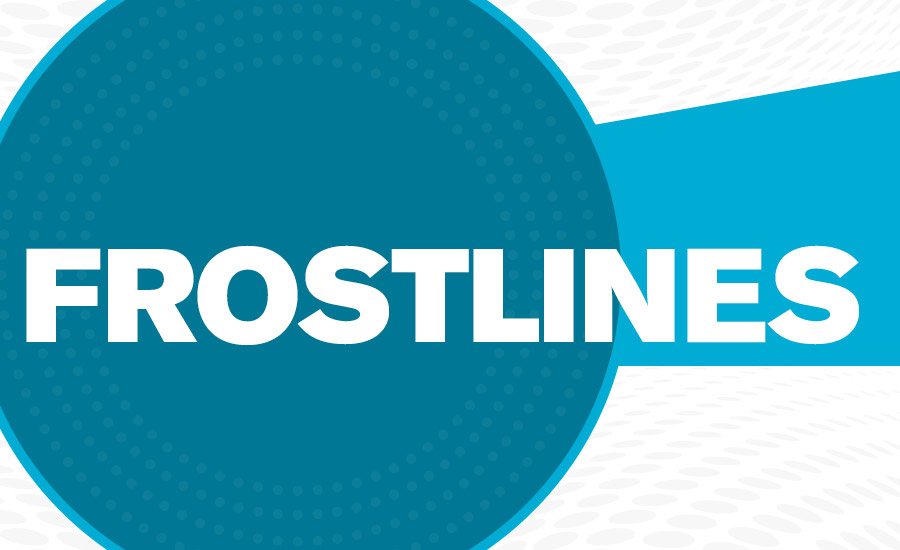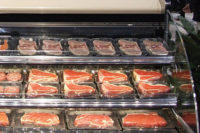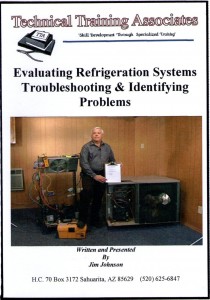In a refrigeration system, service technicians often confuse a liquid line restriction with an undercharge of refrigerant. This confusion will often lead to the technician adding refrigerant to the system with a liquid line restriction, which will in turn lead to an overcharged system. Hopefully, this article will clear up any misconceptions between these two system problems.
RESTRICTIONS
There are multiple ways a thermostatic expansion valve (TXV) can become restricted. Remember that a TXV becoming partially restricted will have the same symptoms as a restriction anywhere in the liquid line. The following are the many ways the metering device (TXV) can become restricted:
- Too much oil in the system;
- TXV adjusted too far closed;
- Plugged inlet screen on TXV;
- Sludge from the byproducts of a compressor burnout;
- Partial TXV orifice freeze-up from excessive moisture in the system;
- Foreign material in orifice of the TXV;
- Oil-logged TXV from refrigerant flooding the compressor;
- Restricted liquid line solder joint;
- Kinked liquid line;
- Receiver outlet valve (king valve) partially closed off;
- Wax build-up in TXV from wrong oil in system; and/or
- Manufacturer’s defect in the valve.
The liquid line begins at the outlet of the receiver and includes the filter drier, sight glass, and any other components located between the receiver and TXV. The filter drier is a very likely component to become restricted from moisture and/or debris accumulation because it is designed to absorb and store debris and moisture.
A restricted filter drier will give the same symptoms as a restricted TXV, since it, too, is in the liquid line (see Figure 1). As mentioned earlier, a system with a restricted metering device has the very same symptoms as a system with a liquid line restriction because of the TXV being part of the liquid line. If the filter drier is restricted enough, it will feel cool or cold to the touch. This phenomenon happens from some of the liquid refrigerant experiencing a slight pressure drop and expanding into vapor as it travels through the filter drier. Vapor bubbles in the sight glass downstream of the filter drier can also be observed if this occurs. This is why it is of utmost importance to have the liquid sight glass downstream, not upstream, of the filter drier.
Filter driers are designed to remove foreign material from a refrigeration or air conditioning system, and they are notorious for becoming restricted from moisture, sludge, dirt, or oil that has entered the system due to poor service practice or extreme operating conditions. These foreign materials can include moisture, dirt, sand paper grit, soldering flux, small solder beads, and acid. However, it is excessive moisture that causes most filter driers to become restricted.
Some sources of moisture in refrigeration and air conditioning systems include:
- Improper brazing or soldering techniques;
- Leaky systems;
- Improper evacuation techniques;
- Improper handling of hygroscopic system lubricants; and/or
- Improper handling of system piping at installation.
Liquid line restrictions cause the evaporator, compressor, and condenser to be starved of refrigerant, causing the mass flow rate or refrigerant through the system to decrease. Often, liquid refrigerant will accumulate in the bottom of the condenser and receiver, and condenser subcooling readings will be normal to high because of this. The system will have symptoms of low suction pressures, high evaporator and compressor superheats, normal to high condenser subcooling, low compressor amp draws, and low head pressures.
RESTRICTION CHECKLIST
Any restriction or damage to the liquid line from the receiver outlet to the metering device inlet will have similar symptoms as a restricted filter drier. Because the filter drier is located in the liquid line, a restricted filter drier can now be referred to as a liquid line restriction. To determine if the problem is a partially restricted filter drier, follow the checklist below:
Assume that this R-134a refrigeration system is a TXV/receiver system employing a filter drier and sight glass.
Measured Values:
- Compressor discharge temperature - 215°F
- Condenser outlet temperature - 70°F
- Evaporator outlet temperature - 30°F
- Compressor inlet temperature - 60°F
- Ambient temperature - 70°F
- Refrigerated space temperature - 30°F
- Compressor volts - 230v
- Compressor amps - Low
- Low-side (evaporator) pressure - 1.8 psig (minus 10°F)
- High-side (condensing) pressure - 95 psig (85°F)
Calculated Values:
- Condenser split - 15°F
- Condenser subcooling - 15°F
- Evaporator superheat - 40°F
- Compressor superheat - 70°F
When liquid line restrictions occur, many technicians believe that if any part of the system’s high side is restricted or plugged, head pressures will elevate. This is simply not the case, especially on a TXV/receiver system. A restricted liquid line will starve the evaporator of refrigerant, causing low evaporator pressures.
With a starved evaporator, the compressor will also be starved of refrigerant, and there will be little heat for the condenser to reject. This small amount of heat to reject will cause a low condensing pressure and temperature. Most of the refrigerant will then be stored in the condenser and receiver, simulating a pumped-down refrigeration system.
Symptoms of a liquid line restriction include:
- Low evaporator (suction) pressure;
- High superheats;
- Higher-than-normal discharge temperatures;
- Low amp draw;
- Short-cycle on low-pressure control (LPC);
- Somewhat high discharge temperature;
- Low condensing (head) pressure;
- Low condenser split;
- Normal to a bit high condenser subcooling; and/or
- May be a local cool spot or frost after the restriction.
As mentioned earlier, most of the refrigerant will be in the receiver, with some in the condenser. The condenser subcooling will be normal to a bit high because of this. The refrigerant flow rate will be low through the system from the restriction, which will cause what refrigerant that is in the condenser to remain there longer and gain more subcooling. An undercharge of refrigerant will cause low subcooling.
UNDERCHARGED SYSTEM CHECKLIST
For comparison purposes, here is a system checklist for an undercharged system:
Measured Values:
- Compressor discharge temperature - 195°F
- Condenser outlet temperature - 78°F
- Evaporator outlet temperature - 10°F
- Compressor inlet temperature - 50°F
- Ambient temperature - 70°F
- Box temperature - 20°F
- Compressor volts - 230v
- Compressor amps - Low
- Low-side (evaporator) pressure - 3.94 inches Hg (minus 20°F)
- High-side (condensing) pressure - 86.4 psig (80°F)
Calculated Values:
- Condenser split - 10°F
- Condenser subcooling - 2°F
- Evaporator superheat - 30°F
- Compressor superheat - 70°F
Since the evaporator is starved of refrigerant from the undercharge, there will be high evaporator superheats. This, in turn, will lead to high compressor (total) superheats. The receiver will not be getting enough liquid refrigerant from the condenser because of the shortage of refrigerant in the system. This will starve the liquid line and may even bubble a sight glass if the condition is severe enough. The TXV is not seeing normal pressures and may even be trying to pass liquid and vapor from the starved liquid line. The TXV will also be starved and cannot be expected to control superheat.
Because the compressor will see very hot vapors from the high superheat readings, the gases entering the compressor will be extremely expanded and have a low density. The compression ratio will be high from the low suction pressure causing low volumetric efficiencies. The compressor will simply not be pumping much refrigerant, and all components in the system will be starved of refrigerant.
The 100 percent saturated liquid point in the condenser will be very low, which will cause low condenser subcooling. The condenser will simply not be receiving enough refrigerant vapor to condense it to a liquid and feed the receiver. Condenser subcooling is a good indicator of how much refrigerant charge is in the system. Low condenser subcooling can mean a low charge, while high condenser subcooling can mean an overcharge — but not always. For example, this is not true for capillary tube systems having no receiver; a capillary tube system can run high subcooling simply from a restriction in the capillary tube or liquid line. The excess refrigerant will accumulate in the condenser causing high subcooling and high head pressures. If a TXV receiver system is restricted in the liquid line, most of the refrigerant will accumulate in the receiver, with a bit in the condenser. This will cause low subcooling and low head pressure.
Here are the seven telltale signs of a system low on refrigerant:
- Medium-to-high discharge temperatures;
- High evaporator superheat;
- High compressor superheat;
- Low condenser subcooling;
- Low compressor amps;
- Low evaporator temperatures and pressures; and
- Low condensing temperatures and pressures.
Again, the symptoms of a liquid line restriction are very similar to a system with a refrigerant undercharge; however, the undercharged system will have low condenser subcooling levels. Service technicians often confuse an undercharged system with a restricted metering device, and adding refrigerant to a system with a restricted liquid line will only raise the condenser subcooling amounts to a level where the head pressure may elevate. This is caused from a lack of internal volume in the condenser to hold the added refrigerant. Even the receiver may overfill if too much refrigerant is added. If the system is then pumped down for any reason, dangerous head pressures will be experienced.
In conclusion, it is the condenser subcooling values that differentiate an undercharged system from a system with a liquid line restriction.
See more articles from this issue here!











